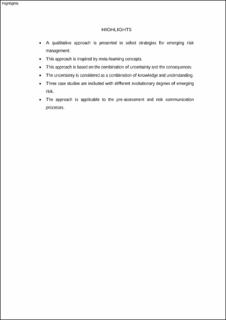| dc.contributor.author | Brocal, Francisco | |
| dc.contributor.author | Paltrinieri, Nicola | |
| dc.contributor.author | Gonzalez-Gaya, C | |
| dc.contributor.author | Sebastian, M A | |
| dc.contributor.author | Reniers, Genserik | |
| dc.date.accessioned | 2021-03-11T14:50:45Z | |
| dc.date.available | 2021-03-11T14:50:45Z | |
| dc.date.created | 2021-03-10T11:12:25Z | |
| dc.date.issued | 2021 | |
| dc.identifier.issn | 0925-7535 | |
| dc.identifier.uri | https://hdl.handle.net/11250/2732965 | |
| dc.description.abstract | Emerging risk models are still scarce and far from agreed upon. They are currently the focus of increasing interest in the occupational context. Consequently, frameworks that deal with emerging risk management in industrial contexts are very recent or, even still, in the development and maturation stage. Uncertainty should be considered as the main characteristic of emerging risk in this context.
It is as such that the main objective of this paper is to develop a qualitative approach inspired by meta-learning lessons to the selection of strategies for emerging risk management, considering uncertainty as the main decision variable in occupational contexts. To this end, uncertainty has been integrated, as a combination of knowledge and understanding, in a theoretical framework on emerging risk. An emerging risk classification scheme has been developed with the results obtained. This scheme makes it possible to estimate the level of emerging risk and management strategies based on the combination of uncertainty and the potential consequences of emerging risk. Such approach has been applied to three case studies with different evolutionary degrees of emerging risk: exoskeletons; nanomaterials; and industrial automation. The proposed approach could be considered primarily as a qualitative tool applicable to the process of pre-assessment and communication of emerging risk. | en_US |
| dc.language.iso | eng | en_US |
| dc.publisher | Elsevier | en_US |
| dc.rights | Attribution-NonCommercial-NoDerivatives 4.0 Internasjonal | * |
| dc.rights.uri | http://creativecommons.org/licenses/by-nc-nd/4.0/deed.no | * |
| dc.title | Approach to the selection of strategies for emerging risk management considering uncertainty as the main decision variable in occupational contexts | en_US |
| dc.type | Peer reviewed | en_US |
| dc.type | Journal article | en_US |
| dc.description.version | acceptedVersion | en_US |
| dc.source.journal | Safety Science | en_US |
| dc.identifier.doi | 10.1016/j.ssci.2020.105041 | |
| dc.identifier.cristin | 1896903 | |
| dc.description.localcode | © 2020. This is the authors’ accepted and refereed manuscript to the article. Locked until 3/11-2023 due to copyright restrictions. This manuscript version is made available under the CC-BY-NC-ND 4.0 license http://creativecommons.org/licenses/by-nc-nd/4.0/ | en_US |
| cristin.ispublished | true | |
| cristin.fulltext | postprint | |
| cristin.qualitycode | 2 | |

